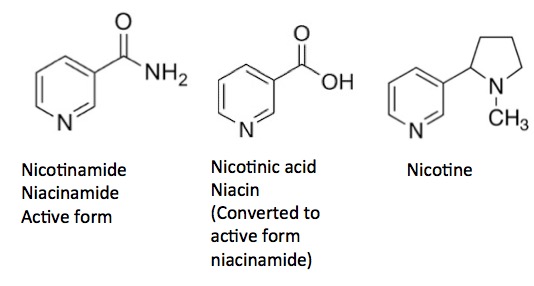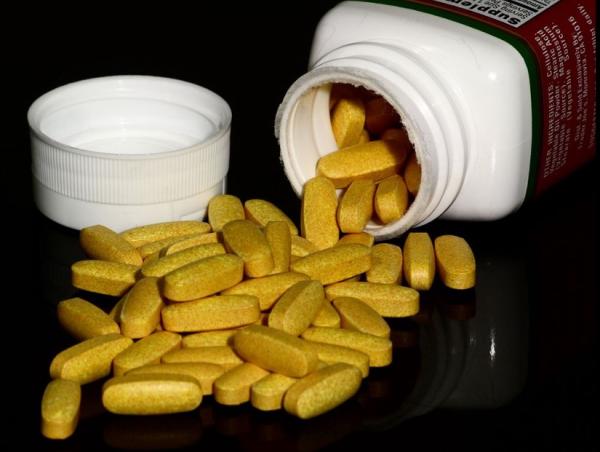Vitamin B3 is smack in the middle of the news because of a study showing that it may help prevent birth defects and miscarriages (See Julianna LeMieux's companion piece "Study Finds Vitamin B3 Prevents Birth Defects And Miscarriages"). Since there are certain aspects of B3 that are confusing, this is probably a good time for a primer about the vitamin:
- It has multiple names, which are similar and confusing
- A bottle of vitamin B3 may consist of one of two closely-related chemicals. But only one of them is really B3
- B3 is essential in all living cells
- Sometimes it's a vitamin and sometimes it's a drug (and a lousy one at that)
NAMES
The terms vitamin B3 and niacin, nicotinic acid are used interchangeably, but this isn't strictly accurate. Confusion can arise from the multiple names associated the vitamin and similar molecules. For example, even though one of the correct names for B3 names is nicotinic acid, it and nicotine could hardly be more different chemically or pharmacologically. They simply share part of the name and part of the chemical structure (Figure 1).

Figure 1. Plenty of "nics." Good for Scrabble, but not for your sanity. Nicotine is included just to illustrate how bizarre organic chemistry nomenclature can be.

Even though nicotine and nicotinic acid are entirely different chemicals, one can be synthesized from the other. Chemical oxidation of nicotine produces nicotinic acid. During this reaction, the pyrrolidine ring (green arrow) is completely destroyed, leaving only one carbon (red circle) behind in the form of a carboxylic acid. The pyridine ring (blue arrow) remains intact.
As if the nomenclature weren't puzzling enough, different names are used by different organizations. For instance, the American Institute of Nutrition uses the term niacin for either nicotinic acid or nicotinamide, while the United States Pharmacopeia (correctly) identifies niacin as nicotinic acid. Although confusing, this difference is largely irrelevant, since either molecule can be incorporated into nicotinamide adenine dinucleotide aka NAD, a hugely important biomolecule, which is found in all living cells. The name 'niacin' is a composite of the terms nicotinic acid plus vitamin.

Nicotinamide adenine dinucleotide (NAD) - Essential for all life forms
FUNCTION
The primary functions of NAD are to promote redox (oxidation-reduction) reactions and to generate chemical energy (ATP). Since NAD is essential to so many physiological processes, a diet that is deficient in vitamin B3 will result in a shortage of NAD in the body (1). This can lead to a serious condition called pellagra, which is essentially a complete body system meltdown. Symptoms of pellagra are called "The Four Ds" - diarrhea, dermatitis, dementia, and death. Pellagra can be fatal if not treated, but it responds very well to vitamin B3 supplementation.
VITAMIN B3 CAN ALSO BE A DRUG
Niacin provides a quintessential example of the gray area that can exist between vitamins and drugs. A partial definition of a drug, according to the FDA is: "A substance intended for use in the diagnosis, cure, mitigation, treatment, or prevention of disease. A substance (other than food) intended to affect the structure or any function of the body."
So, if niacin is part of the diet, or taken in small amounts in vitamin supplements, it is classified as a food. But niacin has another use—reduction of cholesterol. The difference is the dose. The recommended daily intake of niacin is about 15 mg for adults. But to treat elevated cholesterol, the recommended dose is between 500-2,000 mg. In this case, niacin is a drug and a pretty lousy one at that. At high doses, niacin causes flushes (2), which can be unpleasant. But other side effects are worse, especially liver damage (yellow eyes and skin), stomach pain, nausea and vomiting, and allergy-symptoms. It is only modestly effective in reducing cholesterol and is not often used since the statin drugs are better at reducing cholesterol and have fewer side effects.
Notes:
(1) Even in the absence of vitamin B3, the body partially compensates by making it from the amino acid tryptophan, which is found in a large variety of foods, including meat, fish, dairy, and nuts.
(2) An extended release form of niacin called Niaspan, which is supposed to minimize the flush is available. Its list of side effects is similar to that of niacin itself.



